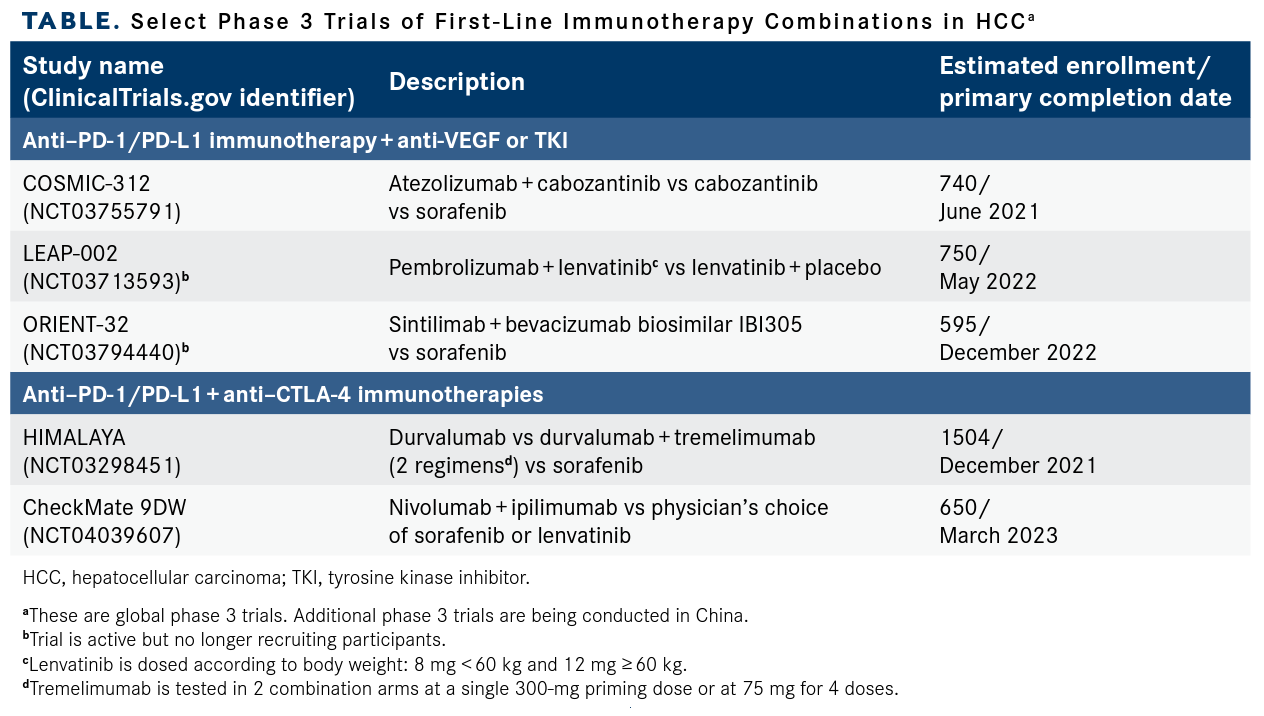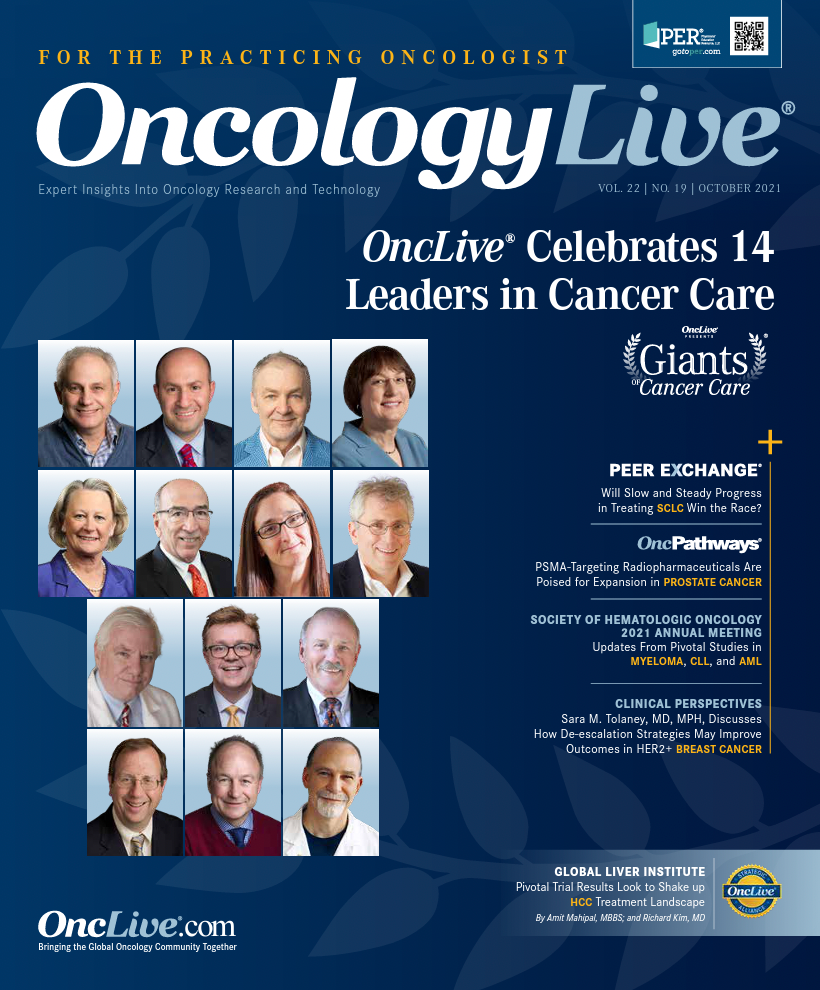Publication
Article
Oncology Live®
IO Combo Anchors a New Front Line Taking Shape in Unresectable HCC
Author(s):
The tide is starting to turn toward more effective frontline systemic therapies for patients with unresectable hepatocellular carcinoma as a result of the introduction of a novel immune-oncology combination.
Bruno Sangro, MD, PhD

The tide is starting to turn toward more effective frontline systemic therapies for patients with unresectable hepatocellular carcinoma (HCC) as a result of the introduction of a novel immune-oncology (IO) combination. There is also the prospect of more innovative therapies in the pipeline, according to liver cancer experts. At the same time, patients are receiving systemic therapies earlier in the course of their disease, resulting in an across-the-board improvement in outcomes.
The combination of atezolizumab (Tecentriq) plus bevacizumab (Avastin) has become the preferred standard for first-line systemic therapy for unresectable disease in several treatment guidelines, including those of the National Comprehensive Cancer Network (for Child-Pugh Class A disease) and European Society for Medical Oncology.1,2
The regimen demonstrated superiority over sorafenib (Nexavar) in this patient population in the phase 3 IMbrave150 trial (NCT03434379), leading to FDA approval for the combination in May 2020.3 Two other therapies, an IO combination of sintilimab plus a bevacizumab biosimilar, and monotherapy with donafenib, a multikinase inhibitor, also have shown improvement over sorafenib in late-stage study results published this year.4,5
“In terms of systemic treatment of HCC, we are just leaving the desert,” Bruno Sangro, MD, PhD, said during a presentation at the International Liver Cancer Association (ILCA) Annual Conference 2021.6 “For decades, we have lived on chemotherapy that proved to be not effective because HCC is truly a chemoresistant tumor. Then sorafenib appeared [in 2007] and for a decade, different tyrosine kinase inhibitors [TKIs] were tested against sorafenib without providing [an improvement in] survival benefit. It is only in the past couple of years that we’ve seen phase 3 trials showing superiority of different options.”
Sangro, who is serving as ILCA president, is director of the Hepatology Unit of the Department of Internal Medicine at the Clínica Universidad de Navarra in Madrid, Spain. During his presentation, he focused on the atezolizumab plus bevacizumab combination. However, he noted that many other regimens are being tested in phase 2 and 3 trials and highlighted several global studies.
Select Phase 3 Trials of First-Line Immunotherapy Combinations in HCCa
a: These are global phase 3 trials. Additional phase 3 trials are being conducted in China.
b: Trial is active but no longer recruiting participants.
c: Lenvatinib is dosed according to body weight: 8 mg < 60 kg and 12 mg ≥ 60 kg.
d: Tremelimumab is tested in 2 combination arms at a single 300-mg priming dose or at 75 mg for 4 doses.

“We are eagerly waiting to see if these other phase 3 trials could bring new combinations or new therapies for patients in the first-line setting for patients naÏve to systemic therapy,” Sangro said. “We should not take for granted that, at least for overall survival, all these combinations will bring new opportunities. We hope so. But we have to wait until the final results are presented.”
At the same time, Sangro said that TKIs hold a place in the treatment landscape, particularly for patients with contraindications to the new IO regimen and as second-line therapy. “I think it’s great that we now have therapy with atezolizumab plus bevacizumab that provides a better outcome as first-line therapy,” Sangro said. “But at the same time, we have to acknowledge that TKIs do work in patients with HCC in the advanced stage. And that is not only that they work as cytostatics and for delayed tumor growth, but they... are able to induce objective remissions that are long lasting.”
Atezolizumab Plus Bevacizumab
The combination of checkpoint inhibition with atezolizumab, an anti–PD-L1 inhibitor, and bevacizumab, an antiangiogenic monoclonal antibody, is the first regimen to show a statistically significant improvement in overall survival (OS) as first-line therapy compared with single-agent sorafenib, Sangro said. In 2007, the FDA approved sorafenib, which inhibits multiple kinases including several involved in angiogenesis, for the treatment of patients with unresectable HCC based on findings from the phase 3 SHARP study (NCT00105443).7
Although sorafenib outcomes have proved difficult to beat, the median OS has increased in both the active and comparator arms in key frontline trials over the years, Sangro noted. The median OS was 10.7 months with sorafenib vs 7.9 months with placebo (HR, 0.69; P < .001) in the SHARP trial; 13.6 months for lenvatinib (Lenvima) vs 12.3 months with sorafenib (HR, 0.92; P not available) in the REFLECT study (NCT01761266); 16.4 months with nivolumab (Opdivo) vs 14.7 months with sorafenib (HR, 0.85; P = .0752) in CheckMate 459 (NCT02576509); and not estimable (NE) with atezolizumab plus bevacizumab vs 13.2 months with sorafenib (HR, 0.58; 2-sided P = .0006) in primary findings from IMbrave150.6
The FDA approved lenvatinib, a multiki-nase inhibitor, for the first-line treatment of patients with unresectable HCC based on its noninferiority to sorafenib in the REFLECT trial. The agency had granted an accelerated approval for nivolumab, a PD-1 inhibitor, in the second-line setting but Bristol Myers Squibb voluntarily withdrew the indica-tion after the immunotherapy agent failed to achieve statistical significance over sorafenib for OS in CheckMate 459.8,9
The improvements in sorafenib efficacy across trials reflect changes in the patient populations considered eligible for systemic therapy, Sangro said. Whereas the SHARP trial enrolled patients with unresectable HCC who were ineligible for any locoregional therapy, IMbrave150 recruited patients with locally advanced or metastatic and/or unre-sectable HCC. “This means that we now consider fit for systemic therapies patients at a slightly earlier stage in the patient jour-ney—[in other words] patients who are fit for any kind of therapy without having a very grim prognosis,” Sangro said.
In the study, patients were randomized 2:1 to receive atezolizumab at 1200 mg plus bevacizumab at 15 mg/kg every 3 weeks or sorafenib at 400 mg twice a day. The primary end points were OS and progression-free survival (PFS) per RECIST 1.1 criteria by independent review.
Sangro noted that the efficacy of the combination regimen was maintained in updated findings from IMbrave150 reported at the 2021 Gastrointestinal Cancers Symposium. The median OS was 19.2 months (95% CI, 17.0-23.7) among 336 patients who received atezolizumab plus bevacizumab compared with 13.4 months (95% CI, 11.4-16.9) among 165 participants who took sorafenib (HR, 0.66; 95% CI, 0.52-0.85; P = .0009). The median PFS was 6.9 months (95% CI, 5.7-8.6) with atezolizumab/bevacizumab vs 4.3 months (95% CI, 4.0-5.6) with sorafenib (HR, 0.65; 95% CI, 0.53-0.81; P = .0001).10
After a median follow-up of 15.6 months, the confirmed objective response rate (ORR) by RECIST 1.1 criteria among patients with measurable disease at baseline who received atezolizumab/bevacizumab (n = 326) was 30% (95% CI, 25%-35%), including a complete response (CR) rate of 8%. Among those treated with sorafenib (n = 159), the confirmed ORR was 11% (95% CI, 7%-17%), including a CR rate of less than 1%. Moreover, the median duration of response was 18.1 months (95% CI, 14.6-NE) with atezolizumab/bevacizumab vs 14.9 months (95% CI, 4.9-17.0) with sorafenib.
Updated exploratory subgroup analyses also showed a trend for improved OS and PFS with the atezolizumab/bevacizumab combination compared with sorafenib regard-less of etiology. The hazard ratios for median OS and median PFS favored the combination for patients with hepatitis B virus (0.56 and 0.51, respectively) and for participants with hepatitis C (0.43 and 0.68, respectively). For nonviral HCC, the combination was less effective than sorafenib for median OS (HR, 1.05) with a lower median PFS benefit (HR, 0.80).6
Of note, IMbrave150 recruited patients with high-risk features who had been excluded from previous trials, Sangro said. In an updated analysis of the intention-to-treat population (N = 501), patients with high-risk status comprised 19% of those enrolled in the atezolizumab/bevacizumab arm and 22% of participants in the sorafenib arm. Patients with portal vein thrombosis made up 53% and 54% of the investigational and comparative arms, respectively, including 14% and 15% with a tumor thrombosis in the main trunk and/or contralateral portal vein classified as portal vein tumor thrombosis stage Vp4.11,12
In updated data, the atezolizumab/bevacizumab combination resulted in a similar OS benefit compared with sorafenib for patients with high-risk features (HR, 0.62) as it did for those without high-risk features (HR, 0.68).12
Overall, Sangro said, the atezolizumab/bevacizumab combination is a good option for patients with high-risk disease. However, he noted that the risk of esophageal varices and bleeding is an underlying factor with chronic HCC due to portal hypertension. In IMbrave150, patients with Vp4 disease had higher rates of bleeding events with atezolizumab/bevacizumab compared with sorafenib, including for esophageal varices hemorrhage (14% vs 0%) and upper gastrointestinal hemorrhage (7% vs 0%).11
“Patients considered for atezolizumab-/bevacizumab as a first-line systemic option should undergo esophageal varices screening with endoscopy and, if varices are present, particularly if they are large, they should be treated as per standard of care in the institu-tions,” Sangro said.
Lorenza Rimassa, MD

Additional Late-Stage Findings
Sintilimab Combination
Since June 2021, investigators have been reporting positive findings from several other late-stage studies of novel therapies in unresectable HCC.
The combination of sintilimab, an antiPD-1 inhibitor, plus IBI305, a bevacizumab biosimilar, was tested against single-agent sorafenib as first-line therapy for patients with unresectable HCC with hepatitis B virus infection in the phase 2/3 ORIENT-32 study (NCT03794440). The study, which enrolled 595 patients, was conducted in China.
After a median follow-up of 10.0 months, patients who received the combination had a median PFS of 4.6 months (95% CI, 4.1-5.7) compared with 2.8 months (95% CI, 2.7-3.2) for those who were treated with sorafenib (HR, 0.56; 95% CI, 0.46-0.70; P < .0001). In the first interim analysis, the median OS was not reached (NR) in the combination arm (95% CI, NR-NR) compared with 10.4 months (95% CI, 8.5-NR) in the sorafenib group.4
In June 2021, the National Medical Products Administration of China approved the combination as first-line treatment for patients with advanced or unresectable HCC based on the ORIENT-32 findings, according to Innovent Biologics, Inc, a Chinese company collaborating with Eli Lilly and Company to develop the drug.
Chinese regulators also have approved sintilimab, which is marketed in China under the trade name Tyvyt, for classical Hodgkin lymphoma and non–small cell lung cancer (NSCLC) settings. IBI305, known as Byvasda, carries indications for metastatic colorectal cancer, adult recurrent glioblastoma, and advanced NSCLC.13 Meanwhile, the FDA is reviewing a biologics license application for the use of sintilimab in combination with pemetrexed and platinum chemotherapy for the first-line treatment of patients with nonsquamous NSCLC, according to Innovent and Lilly.14
Cabozantinib Regimen
Another regimen yielding positive PFS data combines atezolizumab with cabozantinib (Cabometyx), which was tested against cabozantinib monotherapy and single-agent sorafenib in patients with previously untreated advanced HCC in the phase 3 COSMIC-312 trial (NCT03755791). Cabozantinib, which inhibits multiple TKs including several involved in tumor angiogenesis, is approved for patients with HCC who have been previously treated with sorafenib.15
Findings from a planned primary analysis demonstrate that the combination reduced the risk of disease progression or death by 37% compared with sorafenib (HR, 0.63; 99% CI, 0.44-0.91; P = .0012), according to a joint press release from Exelixis, Inc, and Ipsen, the companies developing the regimen. Although there was a trend toward improved OS, the benefit was not statistically significant and the likelihood of reaching that benchmark is low, the companies said. A final OS analysis is expected in early 2022.16
The findings may have been affected by factors including patient demographics, subsequent anticancer therapy, and the impact of the COVID-19 pandemic on the trial, Michael M. Morrissey, PhD, Exelixis’ president and CEO, said in the press release. The company plans to discuss next steps for a potential regulatory filing with the FDA.16
Donafenib Monotherapy
In another study conducted in China, investigators report that donafenib, a modified form of sorafenib, demonstrated superior OS outcomes compared with sorafenib in a phase 2/3 trial involving patients with unresectable or metastatic HCC who had not received prior systemic therapy.
In the full analysis set of 659 patients, the median OS was 12.1 months (95% CI, 10.3-13.4) among the 328 participants treated with donafenib compared with 10.3 months (95% CI, 9.2-12.0) for the 331 patients who received sorafenib (HR, 0.831; 95% CI, 0.699-0.988; P = .0245). The confirmed ORR was 4.6% with donafenib vs 2.7% with sorafenib.
The findings make donafenib the only monotherapy to demonstrate superiority over sorafenib for this patient population, resulting in a new first-line option for patients in China, investigators said.5
Future Directions
The prospect of new frontline options for patients with unresectable HCC raises numerous clinical questions. During the ILCA 2021 presentation, attendees asked whether clinical trials that use sorafenib as a comparator are outmoded in light of recent data.
Lorenza Rimassa, MD, who presented a case-based discussion of the atezolizumab/ bevacizumab combination during the presentation, said most ongoing trials are comparing novel therapies with sorafenib or lenvatinib. “We probably will never have a direct comparison” of novel regimens, said Rimassa, an associate professor of medical oncology at Humanitas University and head of gastrointestinal oncology at Humanitas Cancer Center, Humanitas Research Hospital-IRCSS (Scientific Institute for Research, Hospitalization and Healthcare) in Milan, Italy.
She said clinicians would have to compare novel regimens through indirect comparisons such as meta-analyses and other statistical approaches.
“If these trials are positive and eventually all the combinations get approved, and then reimbursed and so available for us as physicians, we will have to choose,” Sangro said. “Of course, safety issues will be an important point when you have to decide what to use, what combination to use, what treatment to use.”
Second-line therapy is another area with a growing menu of choices but sparse data to guide recommendations.
Overall, Sangro noted that IO combination therapy might not be appropriate for subgroups of patients with contraindications for immunotherapy such as those who need immunosuppressive therapy or have autoimmune conditions. Similarly, some patients have contraindications for antiangiogenics such as recent cardiac events or thrombosis.
“At the end of the day, we will have a very interesting time,” Sangro said. “We really need to share opinions so that we can all together make wise decisions and recommendations,” he said.
References
- Carlino MS. NRAS and other emerging targetable mutations in melanoma. Presented at: 2021 American Society of Clinical Oncology Annual Meeting; June 4-8, 2021; virtual. https://bit.ly/3F3Ykyc
- Robert C, Long G, Mohr P. Shaping tomorrow today: what does the future hold for melanoma? Presented at: European Society for Medical Oncology 2021 Industry Satellite Symposium; September 21, 2021; virtual. https://bit.ly/3ARDEaa
- Garcia-Alvarez A, Ortiz C, Muñoz-Couselo E. Current perspectives and novel strategies of NRAS-mutant melanoma. Onco Targets Ther. 2021;14:3709-3719. doi:10.2147/OTT.S278095
- Wood K, Luke J. The biology and therapeutic approach to BRAF mutant cutaneous melanoma. AJHO. 2017;13(1):4-10. https://bit.ly/2Y5MVg8
- Kim TW, Lee J, Shin SJ, et al. Belvarafenib, a novel pan-RAF inhibitor, in solid tumor patients harboring BRAF, KRAS, or NRAS mutations: phase I study. J Clin Oncol. 2019;37(suppl 15):3000. doi:10.1200/JCO.2019.37.15_suppl.3000
- Monaco KA, Delach S, Yuan J, et al. LXH254, a potent and selective ARAF-sparing inhibitor of BRAF and CRAF for the treatment of MAPK-driven tumors. Clin Cancer Res. 2021;27(7):2061-2073. doi:10.1158/1078-0432.CCR-20-2563
- Normanno N. NRAS in melanoma: ESMO biomarker factsheet. OncologyPro. Updated August 1, 2015. Accessed September 28, 2021. https://bit.ly/3mfCgbe
- Albino AP, Le Strange R, Oliff AI, Furth ME, Old LJ. Transforming ras genes from human melanoma: a manifestation of tumour heterogeneity? Nature. 1984;308(5954):69-72. doi:10.1038/308069a0
- Hayward NK, Wilmott JS, Waddell N, et al. Whole-genome landscapes of major melanoma subtypes. Nature. 2017;545(7653):175-180. doi:10.1038/nature22071
- NCCN. Clinical Practice Guidelines in Oncology. Melanoma: cutaneous, version 2.2021. Accessed September 28, 2021. https://bit.ly/2Y5MRha
- Larkin J, Chiarion-Sileni V, Gonzalez R, et al. Five-year survival with combined nivolumab and ipilimumab in advanced melanoma. N Engl J Med. 2019;381(16):1535-1546. doi:10.1056/NEJMoa1910836
- Dummer R, Schadendorf D, Ascierto PA, et al. Binimetinib versus dacarbazine in patients with advanced NRAS-mutant melanoma (NEMO): a multicentre, open-label, randomised, phase 3 trial. Lancet Oncol. 2017;18(4):435-445. doi:10.1016/S1470-2045(17)30180-8
- Kisqali. Prescribing information. Novartis Pharmaceuticals Corporation; 2021. Accessed September 28, 2021. https://bit.ly/3kR2jpQ
- A phase Ib/II study of LEE011 in combination with MEK162 in patients with NRAS mutant melanoma. ClinicalTrials.gov. Updated December 7, 2020. Accessed September 28, 2021. https://clinicaltrials.gov/ct2/show/results/NCT01781572?view=results
- Hanmi Pharmaceutical enters into an exclusive license agreement with Genentech for a novel oral RAF inhibitor. News release. Hanmi Pharmaceutical Co Ltd. September 29, 2016. Accessed September 29, 2021. https://bwnews.pr/3AVIUcJ
- Janku F, Iyer G, Spreafico A, et al. A phase I study of LXH254 in patients (pts) with advanced solid tumors harboring MAPK pathway alterations. J Clin Oncol. 2018;36(suppl 15):2586. doi:10.1200/JCO.2018.36.15_suppl.2586






















.jpg?fit=crop&auto=format)


